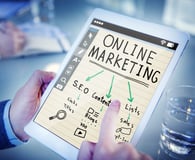Index Content
The flywheel may not ring a bell, but have you heard of the sales funnel? Flywheel marketing aims to replace the usual sales funnel with a wheel (circle) that keeps on turning. Let's explain how it works!
what is flywheel marketing?
Flywheel marketing is a new concept that has landed very strongly in the inbound marketing sector. But, to understand it, we must first know how the sales funnel or marketing funnel works. Let's review it.
The marketing funnel or sales funnel is a concept that is used especially in marketing when we launch an online website and can also be applied to blogs or forums that have a commercial intention, that is, to achieve a final sale after having gone through a series of phases that convert users into our customers.
A sales funnel is, therefore,the process that a brand will follow from the moment users come to it in search of information until this user becomes a customer, and therefore, a sale for our online website of one of our products or services.
We could say then that the marketing funnel is the way to create a sales process whose main objective is the funnel. If we imagine it visually, it is shaped like a funnel in which all actions are directed to the ultimate goal: the customer. The marketing and sales funnel is based on attracting a large number of users (lead acquisition) to the first stages of contact with the brand. A somewhat smaller number go to the following stages of deepening and finally, even fewer users become final customers. As in each phase there are fewer people than in the previous one, the resulting scheme is shaped like a funnel.
The main stages through which a sales funnel is built are:
- TOFU: this will be the highest part of our sales funnel. It refers to the first stage of the sale, the attraction phase. When users start to consider that they need to find a solution to their problem or need and start looking for brands, this is where the work of the first phase comes into play as the user does not yet know anything about our products or services.
- MOFU: in this second stage, the decision stage, the user has already decided what type of product or service they need to solve the problem for which they have been looking for help in the first stage of our sales funnel. However, they still need to evaluate various options before making a decision: take into account the prices offered for the same services by our competitors, for example. This stage is key to determine whether our user will finally become a lead, i.e., it is the first business opportunity we will have.
- BOFU: this period corresponds to the end of the funnel, where the user has already become a lead and will make a purchase of our products or services. It is at this moment when commercial strategies come into action and we will have to offer the best of our brand to achieve a highly satisfactory sale.
However, to innovate a little in this concept, Hubspot launched an initiative, decided to turn it around and design it in a different way: instead of a funnel, it would be a circle in which customers would be in the centre. In this way, our entire marketing strategy would revolve around our customers, putting them in the focus, as intended by inbound marketing.
what does flywheel marketing bring us?
James Watt created this model in the shape of a wheel to represent energy efficiency. Like the wheels of a train or a car, the amount of energy it stores depends on the speed at which it spins, the friction or interference it encounters and the size. What does this mean? With flywheel marketing we focus all our marketing energy, harnessing the momentum of a satisfied customer to get referrals and repeat sales. Basically, your business spins and spins (like a wheel).
What this process aims to do is to optimise the sales cycle a little more, instead of developing a funnel in which, when you reach the end, you have to start all over again, you create a circle that optimises the process because it never closes and you have to start all over again.
This means that we also work more assiduously on the customer loyalty process because everything is focused on that. Hubspot goes so far as to say that the new inbound methodology is a circle: it is flywheel marketing .
Therefore, once we have the customer at the centre of the focus, three phases are developed around him that are related and feed back on each other. Each of them are related to the three previously mentioned (TOFU, MOFU and BOFU):
- Attract: In the attraction stage, we use our experience and knowledge of the sector to create appropriate content in order to get the attention of our ideal customer: our target audience, to whom we want to direct our commercial attention.
- Involve: In the involvement stage, what we seek to do is to create links with users, thus beginning a communication stage in which a relationship is created with the user and the company, trying to get involved in understanding their needs in order to offer the best of ourselves.
- Delight: In the final stage, we must delight the user who has become our client, continuing to offer our attention and the best of us. In this way, we will ensure that our client becomes loyal to our brand, as they will feel that they are part of it.
what do you think about flywheel marketing? Are you ready to implement flywheel marketing in your company? We know that it will be a long process, since it involves adapting our entire business strategy, but we can assure you that the results will be worth it. If you have any doubts, at Occam Agencia Digital we are ready to help you. Contact us!





